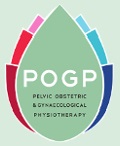Recently I’ve had a number of patients who have done really well with women’s health physiotherapy to treat their prolapse symptoms. They’re always surprised that it works, but they shouldn’t be – as there’s good evidence to show that strengthening your pelvic floor muscles (pfms) and making some lifestyle changes can reduce or resolve symptoms of a pelvic organ prolapse.
Did you know that up to one in two women will develop a prolapse? It’s very common, but not many people talk about it. Some women are really worried when it happens, as they just don’t know what is going on. Basically, it’s when the womb, bladder or bowel bulges into the walls of the vagina, which may have become less firm (or a a bit baggy) and are no longer able to support your pelvic organs. (It’s a bit like a hernia bulging into or slipping down the vaginal wall.) Not all women will have any symptoms, and they’re lucky. But if you feel a lump or a bulge in the vagina, or as if ‘something’s there’, or that ‘something’s come down’, or you get an aching, dragging feeling if you’ve been active or on your feet all day, then it can really affect the quality of your life. It can also cause urinary and bowel symptoms or make you feel uncomfortable during sex.
Prolapses can develop for several reasons which usually involve damage to the ligaments and muscles of the pelvic floor – for example, during pregnancy and childbirth, or strenuous jobs involving heavy lifting, or a history of constipation and/or straining to empty your bowels. Being overweight doesn’t help. It’s thought that you’re more at risk if your mother had one (because the connective tissue down there may not be as firm as it could be), or if you’ve been told you’re hypermobile, which is also a problem involving weak connective tissues. Oestrogen levels also play a part. (These are the hormones that help to keep your pfms and vaginal walls firm.) If you’re postnatal and breastfeeding, or going through the menopause or post-menoapausal, you’ll have less oestrogen down there, which means things will be less firm.
So what can you do? People often don’t realise that one of the roles of the pelvic floor is to protect and support your pelvic organs. The pfms are effectively your muscular undercarriage. If you strengthen them, you can bulk them up, and make them a firmer platform to support your vaginal walls and pelvic organs. If you brace your pfms (ie tighten them) every time you lift something, you’ll be strengthening your pfms just by using them functionally. Ideally, though, you should avoid heavy lifting if you have been diagnosed with a prolapse, to avoid making your symptoms worse.
The good news is that women’s health physiotherapy can help to reduce your symptoms or even make them go away. A fifth of patients who took part in research studying the effect of pfm training on prolapses had a slightly smaller prolapse by the end of the study. More than half said their prolapse felt better and they had less severe or less frequent symptoms. They were also less likely to need further treatment. Given the fact that 10% of women will go on to have surgery to repair a prolapse at some point in their life, this is serious.
So, if you have a prolapse, why not give supervised pfm training a go and make some lifestyle changes to reduce the risk of needing surgery in the future and at the same time improve your quality of life? As a specialist Women’s Health Physiotherapist, I am qualified to teach you how to do your pelvic floor exercises correctly in a way that will strengthen them, and to give you evidence-based advice and information that might just make your prolapse symptoms better or even go away.
If you’d like to talk about anything written here, please contact me below. I’m happy to answer any queries and/or discuss treatment options with you.



